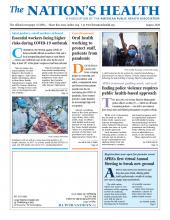
Dentists in Columbus, Ohio, work on a patient May 1 as the state entered Phase 1 of reopening following closures for the COVID-19 outbreak. More physical distancing and higher costs for personal protective equipment are straining practices.
Photo by Megan Jelinger, courtesy Reuters
Dentistry is a messy job. From scraping plaque to removing cavities, procedures send saliva, contaminated water and bacteria from patient mouths into the air. And during the COVID-19 pandemic, those routine practices make dentistry an increasingly high-risk occupation.
“Almost everything done in the chair produces aerosols,” said Josefine Ortiz Wolfe, PhD, RDH, CHES, chair of APHA’s Oral Health Section and director of oral health at the Texas Health Institute. “There is a tremendous amount of risk there, and providers have had to adjust practice based off a lot of unknowns with this virus.”
During the early months of the pandemic, many dental offices closed entirely, or only saw patients for emergencies, leaving dentists, hygienists, assistants and other staff out of work. Now that they are slowly reopening, practices are balancing the health dangers posed by the pandemic with economic pressures and requests from patients who have gone months without care.
About 1 in 5 dental offices in the U.S. were completely closed and not seeing any patients in late March, and 3 out of 4 were only seeing emergency patients, according to a poll from the American Dental Association’s Health Policy Institute. More practices began reopening in May with fewer patients, and as of mid-June, almost all dental practices were open in some capacity, with about one-third describing their practice as “business as usual,” the poll said.
To protect both workers and patients, dental offices have made sweeping changes, following guidance from professional organizations and industry experts. They have altered the kinds of protective gear they use, limited the number of patients they see per day and, in some offices, invested heavily on specialty equipment to make offices safer.
But more guidance is needed, according to APHA’s Oral Health and Occupational Health and Safety Sections, which called for better information from the federal government on how dentists should operate their offices given the pandemic. Dental teams have the highest occupational risk among all workers, with hygienists the single highest-risk profession, the Sections said in a June letter to U.S. Health and Human Services Secretary Alex Azar, JD.

COVID-19 has shuttered dental offices for months, but those that are able to have been reopening, albeit with new safety precautions. Fewer dental offices and longer wait times threaten access to oral health care and can endanger patients.
Photo by XiXinXing, iStockphoto
That “designation should result in additional levels of health protection beyond what is recommended for other health care industries,” the Sections told Azar, asking for input from the Centers for Disease Control and Prevention and Occupational Safety and Health Administration.
Despite the lack of federal guidance, oral health providers are working to make dental care the safest they can.
“Dentists are, and always have been, dedicated health professionals committed to providing the best care in the safest manner possible,” Chad Gehani, DDS, president of the American Dental Association, told The Nation’s Health. “COVID-19 is not the first airborne hazard dentistry has faced, and it will likely not be the last.”
Some offices have eliminated computer check-ins and instituted surveys and temperature checks before patients are allowed treatment. Others are administering a hydrogen peroxide rinse in an attempt to kill pathogens in patient mouths, though CDC says the treatment has yet to be proven effective.
But the transition has not been seamless.
“We are doing a lot of what we have always done in terms of infection control, but now we’re doing even more of it, so that makes everything take longer,” John Tsaknis, DDS, owner of City Dental, a practice in Washington D.C., told The Nation’s Health.
Part of the challenge is the additional personal protective equipment needed. Tsaknis and his team now wear N95 masks, which fit tighter to the face than the normal dental mask, a face shield and a closed coat. The extra layers make providing care physically exhausting.
“Dentists are used to wearing and breathing through masks throughout the day, but this is different — you’re wearing this for nine hours a day,” Tsaknis said. “It’s really hard.”
The extra PPE adds another barrier to care, according to Nammy Patel, DDS, owner of Green Dentistry, a practice in San Francisco. It is like trying to provide dental services while wearing “essentially a hazmat suit,” she said.
“Such an important part of what we do is putting people at ease and making them comfortable,” Patel told The Nation’s Health. “With all of these extra layers, it makes the process very impersonal. It feels like a wall.”
Besides the challenge of keeping health professionals and patients safe, dentists — who are often small business owners — have to contend with higher operating costs and less income. Many are seeing fewer patients due to restrictions on space for physical distancing and have fewer staff working. Time dedicated to sanitizing offices has also increased.
“There is a tremendous amount of risk there, and providers have had to adjust practice based off a lot of unknowns with this virus.”
— Ortiz Wolfe
For some dental teams, including those at City Dental, returning to business as usual does not seem imminent.
“What if it comes back?,” Tsaknis said. “What then? Do we start this all over? If they don’t come up with something, this is our new way of life.”
Large dental offices with multiple rooms and robust systems in place for sterilization may be able to somewhat mitigate the impacts of the pandemic. But smaller offices that might only have one room to see patients and lack some of the more expensive equipment used to clean offices — such as UV lighting systems and specific types of air filtration systems — have a more uncertain future.
“Everything has to be super clean,” Patel said. “I’d estimate over the past 90 days that I’ve spent $10,000 to $15,000 to make everything safer.”
Things are even harder in major cities, such as Washington, D.C., and San Francisco, where property values and taxes are high. With increased need for PPE paired with surging overhead, some dentists have begun charging patients a cash fee to offset additional costs.
But the increased out-of-pocket costs “amplify barriers to care,” Wolfe said. With millions of people in the U.S. unemployed because of the pandemic, many have lost their employer-sponsored dental insurance coverage. And even in the best of times, only about half of U.S. adults have dental coverage, according to CDC.
Fewer dental offices and longer wait times threaten access to care and endanger the health of patients. Going without needed dental care can not only be painful, it can be life-threatening if it leads to an infection. Regular dental care prevents tooth loss and gum disease and can help screen for oral cancers. In 2018, 36% of Americans reported that they had not seen a dentist in the past year, with minorities, people with low incomes and the elderly more likely to not receive care. The fallout from COVID-19 has a potential to increase those disparities even further.
If dental offices close, people who need urgent dental care will end up in emergency departments and hospitals, Wolfe said. The relocation of high-risk, aerosol-producing procedures would shift the increased burden dental care providers have experienced to hospitals. Relieving the stress on hospitals has been a top priority for managing the pandemic response.
“This has been difficult on everyone, but the oral health care system has been disproportionately impacted,” Wolfe said.
For safety guidance for dental practices from the American Dental Association, see www.ada.org.
- Copyright The Nation’s Health, American Public Health Association









